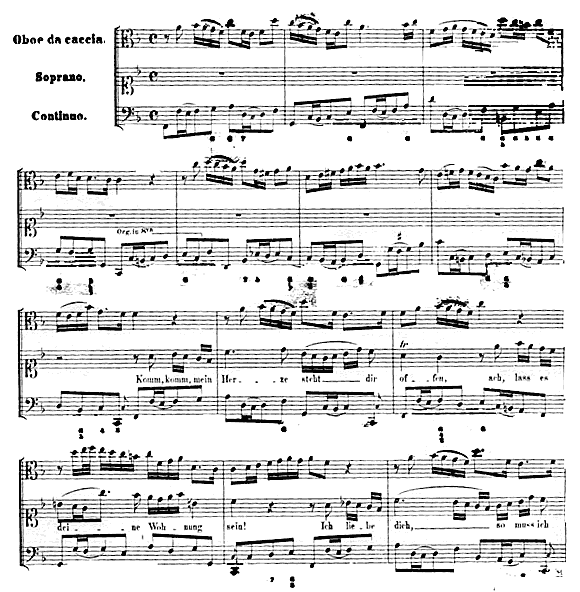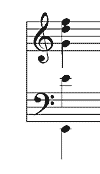Cantata 74 is one of four cantatas intended for Pentecost Sunday (Cantata 34, 59, and 172 are the others). Interestingly enough, this cantata actually borrows from Cantata 59 (it even has the same title!), an earlier Pentecost cantata, though one intended for solo voice. This one (BWV 74) sets a text by Christiane Mariane von Ziegler. The cantata was first performed on Pentecost Sunday (May 20) 1725. Like Cantata 34, discussed above, this one employs a bright scoring, including three trumpets, timpani, two oboes plus oboe da caccia, strings, and continuo. Only the first movement, however, includes the trumpets and timpani, and even in this setting the effect is more subdued than in Cantata 34. This may be a direct reflection of the different focus of this text compared to other Pentecost texts: von Ziegler’s “is more concerned with personal, individual responses to faith” instead of the shouts of the masses of believers (Day, 40-42, cited in Oxford Composer Companions, J.S. Bach, 520).
This is one of those interesting pieces in which we know Bach employed his number-alphabet. In this system, Bach converts letters (German had only 24 in those days) to numerical values to individual works as follows:
- wer=43
- mich=32
- liebet=51
- der=26
- wird=51
- mein=39
- Wort=71
- halten=57
…for a total of 244. This is exactly the number of measures in the first movement, which sets the text “Wer mich liebet, der wird mein Wort halten”. Taking “mein Wort” alone, we see that this totals 110, and Bach writes in this cantata three sections of 110 measures. (Movements 1-3 total 110 measures; the da capo portion of the 7th movement, which is heard twice, is 110 measures.) Three of course is significant in Bach’s works as a reference to the Trinity, perhaps this time reflecting that the third person in the Trinity is the Holy Spirit, whom Christians celebrate in particular on Pentecost. By using the 110 reference three times, Bach also indicates the importance of “mein wort”, my Word, that is, the Word of God.
Below is a summary of the movements comprising Cantata 74:
| Movt. | Type of piece | Key | Meter, Tempo | Scoring | No. of Measures |
| 1 | Chorus | C major | 4/4, moderate | 3 trumpets, timpani, 2 oboes, oboe da caccia, strings, continuo, SATB choir | 61 |
| 2 | Aria | F Major | 4/4 | Oboe da caccia, continuo, soprano solo | 42 |
| 3 | Recitative | d minor to a minor | 4/4, free | Continuo, alto solo | 7 |
| 4 | Aria | E minor | 4/4 | Continuo, bass solo | 77 |
| 5 | Da capo aria | G Major | 4/4 | Strings, continuo, tenor solo | 100 |
| 6 | Recitative | e minor to C major | 4/4, free | 2 oboes, oboe da caccia, continuo, bass solo | 5 |
| 7 | Da capo aria | C major | 3/8 | 2 oboes, oboe da caccia, solo violin, strings, continuo, alto solo | 134 (110 in the da capo portion) |
| 8 | Chorale | a minor | 4/4, moderate to slow | SATB choir, doubled by strings, oboes, and continuo | 13 |
This eight-movement work is really all about the soloists, perhaps because of its focus on the individuals rather than the collective. The SATB chorus is used only in the first and last movements, with the final movement being a simple four-part chorale. But let’s start by looking at the one big choral movement, the opening movement. This has relatively few passages for the full choir, reflecting the ideas of the individuals, rather than the collective Christian community. Instead, short individual statements or overlapping statements by two voice parts is more common. And the sound is not a continuous vocal sound, either, as many phrases are unusually short, compared to other cantatas we’ve heard, and separated by melodic statements by the violins or oboes. The trumpets and drums definitely add some fanfare – so to speak – at the opening and closing of the movement, but their participation in the interior portion is mostly incidental. Of note is the typical Baroque walking bass line throughout this movement, a continuous, fluid passage of eighth notes which constantly propels the music forward.
The second movement is a lovely, rhythmically-complex interplay between three parts: the gentle oboe da caccia, the continuo line, and the soprano soloist. This is one of the movements Bach borrowed from an earlier work, though there the obbligato soloist had been the violin. The oboe da caccia of this setting is softer and more intimate. (The original was also in C major; the choice of F major in this cantata contributes to the gentler feel.) Here, the continuo part is again very active, but the eighth-note movement is ornamented at least once per measure (sometimes twice) with sixteenth-note lower neighbors or passing tones. The interplay between the oboe da caccia and soprano is intriguing. The two parts are absolutely essential in creating this texture, and while there are occasional moments of imitation or brief duets of parallel sixths between the two, they are mostly independent of each other:

The next aria takes its text from the Gospel according to St. John, 14:28. We hear the voice of Christ in the bass soloist:
Note how the voice moves upward at “Ich gehe hin” (I go away), moving away from the tonic note E, then comes back downward on “und komme wieder zu euch” (and come again to you). This pattern repeats several times, using different pitches, throughout the short aria. Another facet which explores the departure-return idea is the continuo part, which repeats the same idea numerous times, not quite an ostinato (which has an exact repeat), but rather the gesture – sometimes extended, sometimes on different pitches, but the essence is the same. Check out the excerpt shown below to see what I mean:
- the green shows the original bass line, plus any exact repetitions
- the red shows an abridged version of that theme
- the purple shows a transposed version
- the yellow shows a passage based on motives from the original theme

The aria that follows provides a lovely contrast to the previous. It is quicker in tempo (or at least feels quicker because of the numerous sixteenth notes), in G major (relative major to the previous movement), scored fully for strings (rather than the sparse continuo), and features the tenor (instead of bass). This movement is almost dance-like, and clearly reflects the opening words:
| Kommt! eilet, stimmet Sait und Lieder in muntern und erfreuten Ton. |
Come, hasten, tune strings and songs in happy and joyful tone. |
The final aria features rapid solo violin writing, which likely is intended to show the rattling of the chains described in the text. This is a da capo aria in which the B section is quite different from the A in both text, texture, length, and musical content – in fact the only thing which seems constant is the 3/8 meter and tempo:
| A | B | |
|---|---|---|
| Length | 110 measures | 24 measures |
| Key | C major | a minor-e minor |
| Scoring | Oboes, strings, solo violin, continuo | Primarily continuo, with some orchestra punctuation (no solo violin) |
| Texture | Busy, but homophonic | Simple homophonic |
| Key text | Hell’s chains | Laughing at Satan’s rage |
Stunning, to many ears, is the strong ninth chord heard before the final cadence of the A section, as well as immediately before the voice enters at the start of the A section:

Given the D, E, F, and G sounding together, this is a pungent moment in the music that you won’t be able to miss!










































